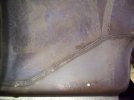MJM
Promoted Users
I know I've read on here that using a flange tool at it's deepest depth, say 1/2" is not advisable due to Ghosting that can occur after final paint.
Take a look at this video and you'll see it's making a small maybe 1/16" bevel on each side of the sheet metal to be welded. Do you think this would also Ghost after final paint?
Take a look at this video and you'll see it's making a small maybe 1/16" bevel on each side of the sheet metal to be welded. Do you think this would also Ghost after final paint?

